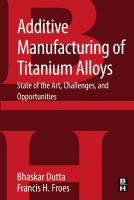Browse content
Table of contents
Actions for selected chapters
- Full text access
- Book chapterAbstract only
Chapter 1 - The Additive Manufacturing of Titanium Alloys
Pages 1-10 - Book chapterAbstract only
Chapter 2 - Raw Materials for Additive Manufacturing of Titanium
Pages 11-23 - Book chapterAbstract only
Chapter 3 - Additive Manufacturing Technology
Pages 25-40 - Book chapterAbstract only
Chapter 4 - Microstructure and Mechanical Properties
Pages 41-50 - Book chapterAbstract only
Chapter 5 - Comparison of Titanium AM Technologies
Pages 51-59 - Book chapterAbstract only
Chapter 6 - Markets, Applications, and Costs
Pages 61-73 - Book chapterAbstract only
Chapter 7 - Recent Developments and Projections for the Future of Titanium AM
Pages 75-84
About the book
Description
Additive Manufacturing of Titanium Alloys: State of the Art, Challenges and Opportunities provides alternative methods to the conventional approach for the fabrication of the majority of titanium components produced via the cast and wrought technique, a process which involves a considerable amount of expensive machining.
In contrast, the Additive Manufacturing (AM) approach allows very close to final part configuration to be directly fabricated minimizing machining cost, while achieving mechanical properties at least at cast and wrought levels. In addition, the book offers the benefit of significant savings through better material utilization for parts with high buy-to-fly ratios (ratio of initial stock mass to final part mass before and after manufacturing).
As titanium additive manufacturing has attracted considerable attention from both academicians and technologists, and has already led to many applications in aerospace and terrestrial systems, as well as in the medical industry, this book explores the unique shape making capabilities and attractive mechanical properties which make titanium an ideal material for the additive manufacturing industry.
Additive Manufacturing of Titanium Alloys: State of the Art, Challenges and Opportunities provides alternative methods to the conventional approach for the fabrication of the majority of titanium components produced via the cast and wrought technique, a process which involves a considerable amount of expensive machining.
In contrast, the Additive Manufacturing (AM) approach allows very close to final part configuration to be directly fabricated minimizing machining cost, while achieving mechanical properties at least at cast and wrought levels. In addition, the book offers the benefit of significant savings through better material utilization for parts with high buy-to-fly ratios (ratio of initial stock mass to final part mass before and after manufacturing).
As titanium additive manufacturing has attracted considerable attention from both academicians and technologists, and has already led to many applications in aerospace and terrestrial systems, as well as in the medical industry, this book explores the unique shape making capabilities and attractive mechanical properties which make titanium an ideal material for the additive manufacturing industry.
Key Features
- Includes coverage of the fundamentals of microstructural evolution in titanium alloys
- Introduces readers to the various Additive Manufacturing Technologies, such as Powder Bed Fusion (PBF) and Directed Energy Deposition (DED)
- Looks at the future of Titanium Additive Manufacturing
- Provides a complete review of the science, technology, and applications of Titanium Additive Manufacturing (AM)
- Includes coverage of the fundamentals of microstructural evolution in titanium alloys
- Introduces readers to the various Additive Manufacturing Technologies, such as Powder Bed Fusion (PBF) and Directed Energy Deposition (DED)
- Looks at the future of Titanium Additive Manufacturing
- Provides a complete review of the science, technology, and applications of Titanium Additive Manufacturing (AM)
Details
ISBN
978-0-12-804782-8
Language
English
Published
2016
Copyright
Copyright © 2016 Elsevier Inc. All rights reserved.
Imprint
Butterworth-Heinemann
